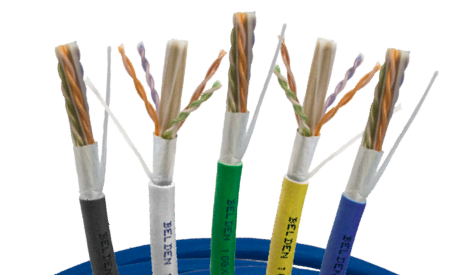What ANSI/TIA-1152 Says About Category 6A Testing
Whether you’re installing a brand new cabling system or attempting to troubleshoot a problem with existing cabling, testing plays an important role in verifying overall cable performance.
Networks are evolving to support more users and more devices, which also changes what is expected and required in terms of cabling performance. When cable has been properly tested, you can rest assured that it is providing the correct transmission capabilities to support users’ needs and applications.
Standards for Cable Testing
The following ANSI/TIA standards provide guidelines to follow when testing new and existing cable systems:
1. ANSI/TIA-568.0-D
(Generic Telecommunications Cabling for Customer Premises)
ANSI/TIA-568.0-D provides generic structure, topologies, distances, installation, performance and testing requirements for telecommunications structured cabling. ANSI/TIA-568-C.2 contains the minimum performance parameters that each category of cabling – from Category 3 to Category 6A – must meet.
2. ANSI/TIA-568-C.2
(Balanced Twisted-Pair Cabling and Components Standard)
ANSI/TIA-568-C.2 references the version of ANSI/TIA-1152 that was ratified in 2009.
3. ANSI/TIA-1152
(Requirements for Field Test Instruments and Measurements for Balanced Twisted-Pair Cabling)
The ANSI/TIA-1152 is in the process of being revised; when published, it will include guidelines for field testing Category 8 cabling. Category 8 cabling will require testers that are capable of testing to 2000 MHz for 25 and 40 Gbps Ethernet transmission.
The ANSI/TIA-1152 Standard specifies the reporting and accuracy performance requirements for field testers of permanent links and channels for Category 5e through Category 6A cable:
- Level IIe performance is required for up to and including Category 5e cabling
- Level III performance is required for up to and including Category 6 cabling
- Level IIIe performance is required for up to and including Category 6A cabling
ANSI/TIA-1152 also outlines all of the required permanent link and channel tests that must be performed and reported in a cable field tester. Below, we explain each one.
-
Wiremap (including shield connection, if present):
Determines whether a copper twisted-pair cable is connected to the correct pin at the other end.
-
Insertion Loss:
Measures the signal power at the far end of the cabling as compared to the signal power at the beginning of the cabling. The result is measured in decibels (dB).
-
Length:
Verifies the physical length of a cable installation.
-
Near-End Crosstalk (NEXT) Loss, local end and far end:
Unwanted signal coupling from one pair of a cabling at the near-end onto a different pair of the cabling at the near end. NEXT is worse on wire pairs that aren’t tightly twisted.
-
Power-Sum Near-End Crosstalk (PSNEXT) Loss, local end and far end:
Measures NEXT in the ends of cables due to close proximity. A measurement of the unwanted signal coupling from multiple cable pairs at the near-end into a cable pair measured at the near‑end.
-
Attenuation to Crosstalk Ratio, Far End (ACRF):
Measures signal-to-noise ratio for the cabling.
-
Power Sum Attenuation for Crosstalk Ratio, Far End (PSACRF):
Determines the difference in dB between the test signal and the crosstalk from the other pairs received at the far end of the link.
-
Return Loss, local end and far end:
Measures reflections caused by impedance changes at all locations along the link, measured in dB.
-
Propagation Delay:
Measures the amount of time that passes between when a signal is transmitted and when it’s received on the other end of a cabling channel.
-
Delay Skew:
Calculates the difference between the propagation delay for each of the four wire pairs.
Note that alien crosstalk (where an unwanted, disturbing signal is coupled from one 6A balanced twisted-pair component, channel or permanent link to another) is not on the list of ANSI/TIA-1152 standard parameters to be reported.
ANSI/TIA-1152 does provide methods in an annex that “can” be used to measure alien crosstalk in installed Category 6A cabling. Commercial Level IIIe testers from most major manufacturers can perform the tests if an end user, consultant or engineer requires it in the specifications. This requires two sets of testers with a communications link between them. When installed by a Belden-certified installer, Belden Category 6A connectivity and cabling will meet all alien performance specifications by design and do not require alien field testing.

One important note about Belden 6A cable: By design, Belden 6A cable and connectors meet the alien crosstalk requirements that are part of ANSI/TIA-1152; therefore, to achieve the Belden 25-Year Product Warranty, field testing of alien crosstalk isn’t required when the cabling system is properly installed by a certified Belden PartnerAlliance technician.
Belden requires that the above list of standard parameters be included in the test results of each permanent link of an end-to-end Category 6A structured cabling project to obtain a warranty.
Belden Cable: Testing Requirements
We have received several questions during Belden PartnerAlliance training sessions about how often cable test equipment must be calibrated. The answer to this question is stated in ANSI/TIA-1152, which says that all testing equipment should be calibrated according to the manufacturer’s recommendations. Typically, most major manufacturers’ testers will provide an indication of being “out of calibration” if they haven’t been calibrated in over a year.
![System.String[]](https://assets.belden.com/transform/169522ce-2f01-4f44-a701-8b9a6a20b935/al-greiner?io=transform:fill,width:300,height:300)